by Matt Corrion
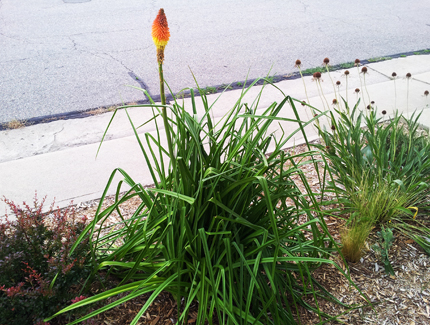
Torch Lilly (Kniphofia uvaria), also sometimes referred to as “Red Hot Poker” is one of my favorite perennials. It is just so unusual. Orange and red are two of my favorite colors, and these plants really stand out in the landscape when in bloom as seen in this photo taken from my garden.
In addition to this plant, I have 3 other types in my garden- a blue leaf variety that is shorter, and gets red and yellow flowers earlier in the summer, one with thinner leaves with bright red flowers that appear in June, and another that gets pale yellow flowers. The one pictured above is the common variety (Kniphofia uvaria). It gets larger than the others and seems to require a little more water.
Aside from the flowers, these plants look great all year round with their grass-like foliage providing texture to the landscape. Torch lily is a awesome addition to any garden!
This is the official blog of Outdoor Design Group, Colorado Landscape Architects. For more information about our business and our services, click here.
Related Posts:
by Matt Corrion
Evergreens are important Xeriscape plants for Colorado landscapes. Since lawn areas are often limited in Xeriscaping design, evergreen plants can step right in to provide rich green color all year long.
Evergreen plants also provide great contrast with other plants, particularly with the the foliage and seed heads of ornamental grasses, and as a backdrop for flowering shrubs and perennials. And evergreens can often be utilized to effectively create privacy and screen or block undesirable views in the landscape.
I am limiting this top 10 list to evergreen shrubs. Another very interesting category of plants are the so called “semi-evergreens”, which are deciduous plants that keep all or part of their foliage throughout the winter. I will do a future list of the top semi-evergreen Xeriscape plants. I am also excluding large trees from this list, as they are a category unto themselves and many people are already familiar with evergreen tree choices.
Although this is a Colorado list, most of these plants can be used in many places throughout the world depending on the local climate.
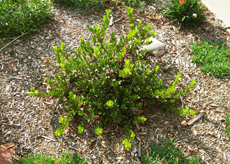
- Panchito Manzanita – Arctostaphylos x coloradoensis ‘Panchito’ Panchito Manzanita is a low growing woody shrub with shiny, oval, dark green leaves that persist throughout the winter. It gets small, pale pink flowers followed by small red berries- but it’s best characteristics are the evergreen foliage and the fact that it requires little care or water. The only time I have had an issue with this plant was when it was placed in an area with very poor soil and poor drainage- even then, the plant looked healthy, it just didn’t get any larger.
- Kinnickinnick – Arctostaphylos uva-ursi Since the Mock Bearberry and Panchito Manzanitas have become some of my favorite plants, I started taking a second look at their cousin the Kinnickinnick. This plant has been around for a long time and thrives in the eastern U.S. Here in Colorado, it needs full to partial shade and requires a little more water. It stays a little smaller than the other Manzanitas, but since there are so few evergreens that thrive in shade it is an invaluable plant.
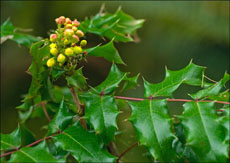
- Oregon Grape Holly – Mahonia aquifolium I consider Oregon Grape Holly to be an evergreen plant, even though that may not be botanically correct. It has large, glossy leaves that persist through winter, turning bronze-red, and gets clusters of small yellow flowers in the spring. It can handle a ton of different conditions, from partial sun, through full shade, and doesn’t seem to mind the toughest clay soil. This plant is a true staple of the Colorado Xeriscape. Oregon Grape Holly gets about 4-6 feet wide and tall, with the “compacta” variety staying about half of that size.
- Yucca – Yucca ssp. Native to the Southwestern United States and Mexico, Yuccas are another plant that is not generally thought of as an evergreen. But they are just about the perfect evergreen plant for a Xeriscape! Yuccas provide really good steady green foliage that can blend in with other plants or be used as a statement with it’s unique form. A tall stalk of white flowers appears in summer to make these plants all the more interesting. All that, from plant that is native to Colorado and requires no maintenance or no supplemental watering! Note: Red Yucca is another great plant that gets red flowers instead of white. It’s scientific name is Hesperaloe parviflora.
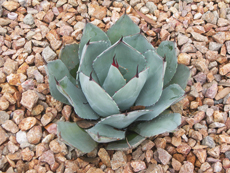
- Agave – Agave parryi Agaves are very similar to Yuccas, and provide many of the same benefits. They tend to grow slower, and are a little smaller, so I recommend using them closer to pathways so their foliage can be enjoyed. Agaves only flower once every 25 years, sending up a very tall flower stalk. After they flower, the parent plant dies, and is replaced bu suckers from the root.
- Dwarf Globe Blue Spruce – Picea pungens ‘Glauca Globosa’ Most people would not consider this a true Xeriscape plant, but I am including it because I have had very good luck with these plants in Xeriscapes. Being a spruce, they do require a little more watering until they are established. However I have seen these plants used in low water use landscaped on the same drip zone as true Xeriscape plants and they have thrived. The blue color and the fact that they stall relatively compact are characteristics that cannot be found with any other plants that I am aware of.
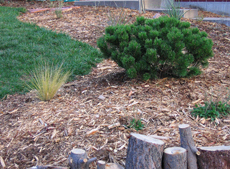
- Mugo Pine – Pinus mugo ssp. Mugo pines can provide very good dark green color, and are perfectly adapted to Colorado’s climate. They are a perfect accent to boulders and flowering perennials. Be sure to give them plenty of room, they are slow growing and are usually pretty small at the time of planting- however most of the varieties will get quite large over time.
- Spreading Junipers – Juniperus horizontalis ssp. Junipers have been given a bad name, as we have written about before, but creeping or spreading junipers require little maintenance and can be very valuable parts of a well designed Xeriscape. These plants work well when mixed with a variety of flowering and deciduous plants and grasses. They can provide good ground coverage and green color to break up large mulch areas and as understory between shrubs. Varieties such as “Youngstown” and “Blue Chip” offer a variety of green to blue-green hues.
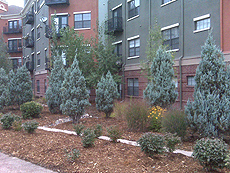
- Upright Junipers – Juniperus scopulorum ssp. These upright shrubs can work well as vertical elements in a Xeriscape (as seen above), or to provide screening of utility areas. Some of the varieties stay very narrow, which can be invaluable in tight spaces where evergreen trees would get far too wide. Be wary of limb breakage in very heavy snows, especially with very narrow varieties such as “Skyrocket”. Junipers are native to Colorado and require very little water, care, or maintenance.
- Compact Tanyosho Pine – Pinus densiflora ‘Globosa’ Compact Tanyosho Pine is a unique large shrub or small tree that has a very nice dark green color and requires minimal maintenance. It is one of the rare evergreen trees that stays very compact, yet requires little water unlike many of the other dwarf conifers. It also has an interesting form, with one or multiple bare trunks at the base with the needles forming a mound at the top.
This is the official blog of Outdoor Design Group, Colorado Landscape Architects. For more information about our business and our services, click here.
Related Posts:
by Matt Corrion
Landscape rebates are becoming popular across the county as water conservation becomes a bigger issue and more people look for ways to save water.
Population growth is straining 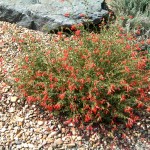 water supplies and delivery systems, causing many water providers to provide great incentives to reduce water use. Homeowner’s, businesses, and HOA’s are also looking for ways to trim their budgets and increase their long-term sustainability.
water supplies and delivery systems, causing many water providers to provide great incentives to reduce water use. Homeowner’s, businesses, and HOA’s are also looking for ways to trim their budgets and increase their long-term sustainability.
But landscape renovations can get expensive. Thankfully, there are some great rebates out there that you can take advantage of to help offset the costs. When you factor in the rebates, as well as significant water and maintenance savings, a landscape renovation can make a lot of sense for your property.
Irrigation Upgrades vs. Turf Removal
Most of the rebates out there focus on 2 main areas: Irrigation Upgrades and Turf Removal.
Irrigation upgrade rebates are offered to water customers to increase the efficiency of their irrigation systems. Rebates are often offered to install more efficient spray nozzles, rain sensors, and controllers.
The rebates for these items are usually calculated per item installed, for example, $5 per efficient rotary nozzle, and $50 for a rain sensor. For larger commercial properties there are often limit to the maximum rebate that can be obtained.
Turf removal rebates are geared toward removing areas of high water-use landscaping (usually lawns and turfgrass) and replacing those areas with low water-use landscaping. The replacement landscaping can consist of Xeriscape, native plants, and a variety of colorful shrubs, perennials, trees, and ornamental grasses.
(more…)
Related Posts:
by Matt Corrion
This idea popped into my head one night at the end of a busy day. As I have written about in the past, one of our specialties at Outdoor Design Group is to work with large residential and commercial properties to renovate their landscaping to save water and maintenance. We call these our Site Renovation services. Often times the landscape is drastically changed, as we convert high water-use areas (usually irrigated lawns) into more sustainable Xeriscape style landscaping with trees, flowering shrubs, perennials, and ornamental grasses. I already knew what these changes looked like on the ground, but I wondered what they might look like from the sky…

(more…)
Related Posts:
by Matt Corrion
Juniper bushes are the most despised landscaping plant in existence. I know this to be true, because 75% of the time that I talk with a homeowner or property owner about renovating their landscape, they say something like “those Junipers have GOT to go!”.
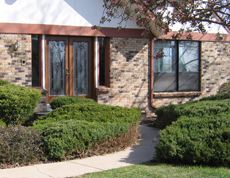
Juniper bushes are common in older landscapes. Here they were not given adequate room, so they have been sheared off along the walkway.
Why is this? I think there are a few main reasons, aside from the fact that they are prickly beasts that we have all tangled with a one point (either landing in one while playing as a kid, or getting that annoying rash on your arm while trimming them) :
1) They were simply overused in the past. People are just tired of them and want something unique and new. And since they live for ages and rarely die, they are often the only living survivors guarding the front doors of homes in any older neighborhood.
2) They were not planted with enough room to grow. Many of the varieties get quite large after say, 20 years, and quickly outgrow the planting bed. Because they grow too large for their setting they require excessive pruning to keep them at a manageable size. This pruning then exposes all of the dead old growth inside the base of the plant- ugly!
3) The aforementioned prickliness. And good luck getting the baseball you were tossing around out of the center of that green monster.
Given these negatives, why then should you consider using Juniper plants in your landscape?
(more…)
Related Posts:






 water supplies and delivery systems, causing many water providers to provide great incentives to reduce water use. Homeowner’s, businesses, and HOA’s are also looking for ways to trim their budgets and increase their long-term sustainability.
water supplies and delivery systems, causing many water providers to provide great incentives to reduce water use. Homeowner’s, businesses, and HOA’s are also looking for ways to trim their budgets and increase their long-term sustainability.
